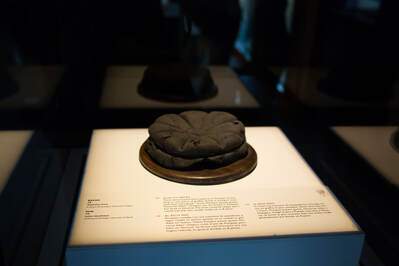"Pompeii: The Eternal City"
the Orlando Science Center
(October 26, 2020 to January 24, 2021)
 A scaled-down, modern reconstruction of an Ancient Roman crane used for heavy lifting [image by Joseph Guinigundo]
A scaled-down, modern reconstruction of an Ancient Roman crane used for heavy lifting [image by Joseph Guinigundo] For a limited time only, the Orlando Science Center is offering a rare opportunity for visitors to see artifacts that were recovered from the volcanic eruption of Mount Vesuvius in 79 A.D. The exhibit is a traveling tour under the banner of "Pompeii: The Eternal City." The items on this tour come directly on loan from Italy, and give visitors a stark reminder that the advancements of society are often dwarfed by the unforgiving power of our planet. The majority of these artifacts come directly from the ruins of Pompeii and its neighboring city of Herculaneum (which suffered equal destruction from Mount Vesuvius).
Before entering the exhibit, visitors are given a somber presentation of what life was like in Pompeii before and during the infamous eruption of 79 A.D. It should be noted that Mount Vesuvius had erupted numerous times throughout history, but 79 A.D. is recognized as its deadliest moment.
"Pompeii: The Eternal City" boasts 100 hundred artifacts alongside modern-day recreations of Ancient Roman technology of the time.
Before entering the exhibit, visitors are given a somber presentation of what life was like in Pompeii before and during the infamous eruption of 79 A.D. It should be noted that Mount Vesuvius had erupted numerous times throughout history, but 79 A.D. is recognized as its deadliest moment.
"Pompeii: The Eternal City" boasts 100 hundred artifacts alongside modern-day recreations of Ancient Roman technology of the time.
 Narcissus and Echo [image by Joseph Guinigundo]
Narcissus and Echo [image by Joseph Guinigundo] Every artifact is special, but there are a couple of items worth highlighting:
PAINTING OF NARCISSUS AND ECHO:
This is a powerful piece of art featuring the tragic mortal, Narcissus (a son of the gods), who fell in love with his own reflection. The nymph, Echo, was equally smitten by Narcissus. Unfortunately for her, Narcissus was repulsed by Echo's advances. Echo, cursed by the gods, was unable to speak for herself. She could only repeat what others were saying to her. The tragedy of Narcissus is that he fell in love with an image that could not love him in return. This artpiece is in remarkable condition.
PAINTING OF NARCISSUS AND ECHO:
This is a powerful piece of art featuring the tragic mortal, Narcissus (a son of the gods), who fell in love with his own reflection. The nymph, Echo, was equally smitten by Narcissus. Unfortunately for her, Narcissus was repulsed by Echo's advances. Echo, cursed by the gods, was unable to speak for herself. She could only repeat what others were saying to her. The tragedy of Narcissus is that he fell in love with an image that could not love him in return. This artpiece is in remarkable condition.
 2,000 year old bread [image by Joseph Guinigundo]
2,000 year old bread [image by Joseph Guinigundo] 2,000 YEAR OLD LOAF OF BREAD:
The inhabitants of Pompeii loved their bread. This particular loaf of bread dates back to 79 A.D. The intense volcanic activity of Mount Vesuvius transformed this loaf of bread into pure carbon. The shape of the bread is completely intact.
 Replicas of molds made from the cavities around human remains from Pompeii dating back to the volcanic eruption of 79 A.D. [image by Joseph Guinigundo]
Replicas of molds made from the cavities around human remains from Pompeii dating back to the volcanic eruption of 79 A.D. [image by Joseph Guinigundo] MOLDS OF POMPEII VICTIMS
These are modern day copies of two human shapes uncovered from the destruction of 79 A.D. The original molds were taken by pouring plaster into the cavities surrounding the skeletal remains in Pompeii. The ones on display at this exhibit are replicas of those molds. One of the human shapes possibly depicts a slave. The other human shape is believed to be a woman on the ground shielding her face with her hands. These are extremely powerful images and representatives of what was Mount Vesuvius in 79 A.D. This room is both somber and terrifying.
When visiting "Pompeii: The Eternal City" Tour, it is recommended not to skip any artifact. These artifacts are over 2,000 years old, and they come from a dark, yet important event in our human history. Each object was used over 2,000 years ago, and there is an aura of mystery behind each item. This is a historical exhibit that brings the wonders of Pompeii to Orlando, and it cannot be stressed just how significant these items are to history. For anyone who wishes to do independent research of this disaster, they should start with the eye-witness accounts of Pliny the Younger (a Roman poet) who wrote about his experience.
The Orlando Science Center has made this exhibit with public safety in mind. There are time slots per entry ticket ensuring that the exhibit rooms have a limited flow of visitors. Masks are required, and social-distancing is highly recommended in each exhibit room.
Write-Up by: Voltaire Guinigundo
Images by: Joseph Guinigundo
Very special thanks to Jeff Stanford (VP, Marketing; Orlando Science Center) for taking the time and providing all of the wonderful insight into this wonderful exhibit!






 RSS Feed
RSS Feed